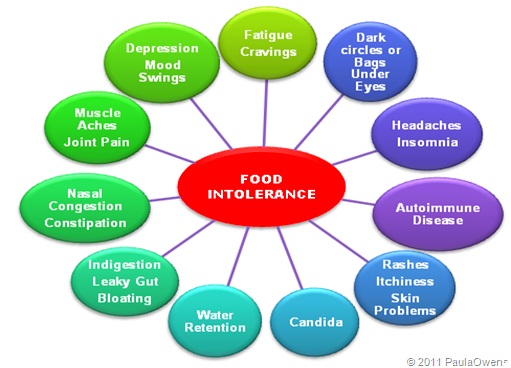
Allergic reactions to foods are often easily diagnosed and obvious ie. Nut allergy. The test used for allergies is IgE antibodies, and often used by GP’s and allergy specialists, either via a blood test or “scratch” test. An allergy involves an immune response from the body with the release of histmines – usually it is immediate, and may result in rash, swelling, and asthma. Taking anti histamines can reduce the severity of the response. The allergy maybe in response to foods, or often environment – such as pollen, dust, animals.
Food intolerances are responsible for symptoms like bloating, indigestion, reflux, headaches, migraines, sinus issues, eczema, asthma, inability to concentrate, fatigue, lethargy, digestive symptoms like IBS (irritable bowel syndrome), aches and pains, inability to lose weight, and potentially mental disorders such as anxiety or depression.
Food intolerances are not as easy to diagnose and can take years to determine, if ever. ThIt is also known as food hypersensitivity. The test used for intolerances is most commonly IgG antibodies. Sometimes IgA is also used, and this test is specially looking at the antibodies produced at the GUT level. High levels of IgA antibodies indicate intestinal permeability or “leaky gut” which can result in autoimmune conditions if not treated.
A food intolerance involves an chemical response via the production of antibodies – but it is a delayed reaction and may occur over several days (hence making if very difficult to diagnose).
When the offending foods are consumed, the body will respond by creating antibodies and subsequent inflammation – our natural defence mechanism. Over the long term this inflammation is detrimental to health.
By eliminating the reactive foods you can significantly reduce symptoms, and improve long term health prospects. It is often hard to determine offending foods, even with restrictive elimination diets, hence scientifically valid and reliable IgG testing is often the preferred method to determine food intolerances. The most common food intolerances that I see in clinic are to Cow’s milk, Wheat and Egg White.
How to test ?
IgG testing is carried out with a blood test, then looking at the specific antibodies to each food. The cost varies depending on how many foods are included in the panel, and which lab is used.
What about Children?
Once a child is eating a variety of foods, the IgG test will be valid. If your child is experiencing from vague symptoms such at headaches, inability to concentrate, fatigue, lethargy, reflux, nausea, or stomach pain they may well be suffering a food intolerance and I would advise for them to be tested so that the offending foods can be eliminated, so they do not need to suffer any longer.
Treatment protocol
The results of IgG testing specifically show which foods are high, medium and low in terms of their antibody response
The treatment protocol in the first instance is to eliminate the offending foods from the diet to allow the body to heal. I will work with you on an individualised protocol to restore the lining of the gut, improve nutrient absorption and improve gut flora. This may take several months and involve changes in the diet and supplementation of key nutrients. After such time, some of the foods that are “low” and “medium” antibody offenders may be able to be re –introduced in limited amounts.

